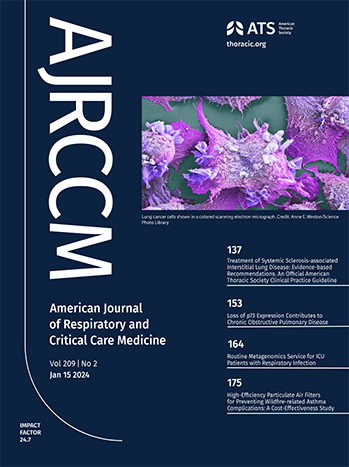Differential Effects of Wildfire Smoke Pm2.5 Exposure on Respiratory Disease Emergency Department Visits in the Western United States.
IF 19.4
1区 医学
Q1 CRITICAL CARE MEDICINE
American journal of respiratory and critical care medicine
Pub Date : 2025-09-10
DOI:10.1164/rccm.202502-0350oc
引用次数: 0
Abstract
BACKGROUND Wildfires significantly affect air quality in the Western United States. Although prior research has linked wildfire smoke PM2.5 to respiratory health outcomes, these studies typically have limited geographic and temporal coverage, lacking evidence from multiple states over extended periods. METHODS We obtained data on over 6 million emergency department (ED) visits for respiratory diseases, including asthma, chronic obstructive pulmonary disease (COPD), upper respiratory infections (URI), and bronchitis, from five states in the Western US during 2007-2018. Daily exposure to wildfire smoke and non-smoke PM2.5 was estimated using a state-of-the-art model system. A time-stratified case-crossover design with conditional logistic regression models was used to assess the acute respiratory effects of smoke and non-smoke PM2.5 exposure. FINDINGS The odds ratios associated with a 1 µg/m3 increase in the 3-day average wildfire smoke PM2.5 were 1.016 (1.015-1.016) for asthma, 1.004 (1.003-1.005) for COPD, 1.001 (1.000-1.011) for upper respiratory infections (URI), and 1.004 (1.004-1.004) for bronchitis. Wildfire smoke PM2.5 had stronger estimated effects than non-smoke PM2.5, particularly for asthma (non-smoke PM2.5: OR 1.002, 1.001-1.004). Stratified analyses showed greater vulnerability among women and adults. Sensitivity analyses confirmed robust associations across exposure windows, while concentration-response functions suggested no clear threshold for adverse effects. CONCLUSION Wildfire smoke PM2.5 was associated with elevated risks of acute respiratory outcomes. Stronger effects were observed from smoke PM2.5 than non-smoke PM2.5, particularly for asthma and upper respiratory infections. These findings underscore the need for targeted public health interventions and further research into the unique toxicological properties of wildfire emissions.野火烟雾Pm2.5暴露对美国西部呼吸系统疾病急诊就诊的不同影响
野火严重影响美国西部的空气质量。尽管先前的研究将野火烟雾PM2.5与呼吸健康结果联系起来,但这些研究通常具有有限的地理和时间覆盖范围,缺乏来自多个州的长期证据。方法:我们获得了2007-2018年美国西部5个州超过600万例呼吸道疾病急诊(ED)就诊数据,包括哮喘、慢性阻塞性肺疾病(COPD)、上呼吸道感染(URI)和支气管炎。使用最先进的模型系统估算了野火烟雾和非烟雾PM2.5的每日暴露量。采用时间分层病例交叉设计和条件logistic回归模型来评估烟雾和非烟雾PM2.5暴露对急性呼吸系统的影响。发现:野火烟雾PM2.5每增加1µg/m3,哮喘的比值比为1.016 (1.015-1.016),COPD的比值比为1.004(1.003-1.005),上呼吸道感染(URI)的比值比为1.001(1.000-1.011),支气管炎的比值比为1.004(1.004-1.004)。野火烟雾PM2.5比非烟雾PM2.5具有更强的估计效应,特别是对哮喘(非烟雾PM2.5: OR 1.002, 1.001-1.004)。分层分析显示,女性和成年人更容易受到伤害。敏感性分析证实了暴露窗口之间的强大关联,而浓度-反应函数表明没有明确的不良反应阈值。结论野火烟雾PM2.5与急性呼吸结局风险升高相关。烟雾PM2.5比非烟雾PM2.5的影响更大,尤其是对哮喘和上呼吸道感染的影响。这些发现强调需要有针对性的公共卫生干预措施,并进一步研究野火排放物的独特毒理学特性。
本文章由计算机程序翻译,如有差异,请以英文原文为准。
求助全文
约1分钟内获得全文
求助全文
来源期刊
CiteScore
27.30
自引率
4.50%
发文量
1313
审稿时长
3-6 weeks
期刊介绍:
The American Journal of Respiratory and Critical Care Medicine focuses on human biology and disease, as well as animal studies that contribute to the understanding of pathophysiology and treatment of diseases that affect the respiratory system and critically ill patients. Papers that are solely or predominantly based in cell and molecular biology are published in the companion journal, the American Journal of Respiratory Cell and Molecular Biology. The Journal also seeks to publish clinical trials and outstanding review articles on areas of interest in several forms. The State-of-the-Art review is a treatise usually covering a broad field that brings bench research to the bedside. Shorter reviews are published as Critical Care Perspectives or Pulmonary Perspectives. These are generally focused on a more limited area and advance a concerted opinion about care for a specific process. Concise Clinical Reviews provide an evidence-based synthesis of the literature pertaining to topics of fundamental importance to the practice of pulmonary, critical care, and sleep medicine. Images providing advances or unusual contributions to the field are published as Images in Pulmonary, Critical Care, Sleep Medicine and the Sciences.
A recent trend and future direction of the Journal has been to include debates of a topical nature on issues of importance in pulmonary and critical care medicine and to the membership of the American Thoracic Society. Other recent changes have included encompassing works from the field of critical care medicine and the extension of the editorial governing of journal policy to colleagues outside of the United States of America. The focus and direction of the Journal is to establish an international forum for state-of-the-art respiratory and critical care medicine.

 求助内容:
求助内容: 应助结果提醒方式:
应助结果提醒方式:


